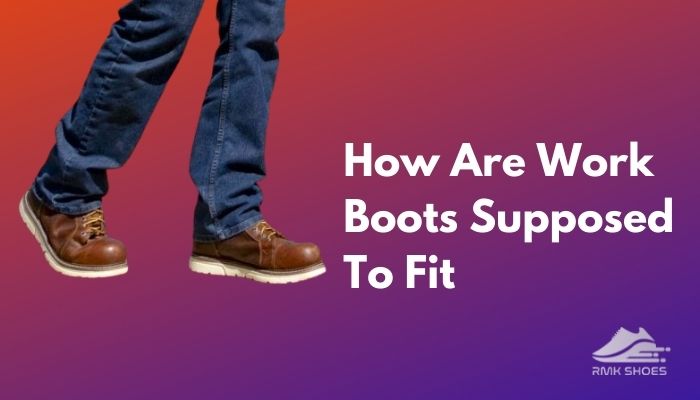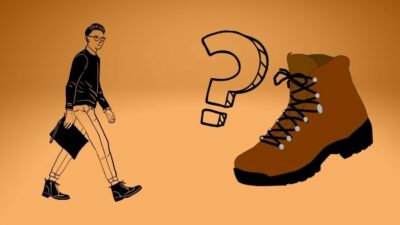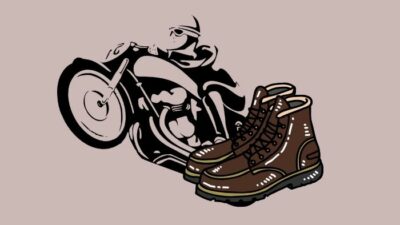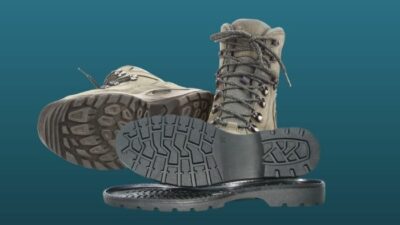To don the work boots, they must fit your feet like a glove. And I understand how time-consuming it is to try on multiple pairs of work boots to obtain the perfect fit.
But hey, why worry when the boot expert is here?
After scouring the internet for hours, I have pinpointed all the key factors that will assist you in getting the best fit of work boots in no time.

So, first thing first, how are work boots supposed to fit?
If you want a detailed guide on the work boot’s fitting, then make sure to read the article till the end.
How Should Work Boots Fit?
In the realm of safety gear, work boots are a trusty name. Their
protection to feet in challenging terrains is commendable.
Whether it is falling objects, cuts, punctures, or withstanding pressure, work boots can solely protect the feet from these odds.
However, to get the most out of your work boots, you need to have a proper fitting of them. Now, most of you have no idea how work boots should fit.
It’s effortless!
Your work boots should neither be too tight or too loose. Instead, they should fit your feet snugly.
Many of you believe that buying more oversized work boots will keep your feet comfortable or that smaller work boots will stretch over time and mold your feet’ shape. The fact is, these are complete hoaxes!
A large pair of work boots will cause your feet to slide inside the boots and cause injuries. Similarly, small work boots can swell your feet and cause blisters.
Neither loose nor tight, work boots should fit your feet perfectly.
Your toes shouldn’t be smashed in work boots. Instead, there should be enough room in the toe box so that you can comfortably move your toes.
When you have the best fit of your work boots, only then can they give you excellent traction and secure footing.
Check out our separate post to know Are Military Boots Good for Work.
How to Get The Right Fit of Work Boots?

When you invest a hefty amount on work boots, you surely don’t want an ill-fitting one. Surprisingly, by following only a few guidelines, you can quickly get the right fit of work boots.
Also, check out our separate post to know Are Work Boots Tax-Deductible
Here are the tips that you can follow to obtain the perfect fit of work boots:
- Wear socks: While buying work boots, try them with socks on. More enormous socks improve blood circulation and allow your feet to breathe. Additionally, if you accidentally buy large work boots, wearing socks will eat up the extra space, assuring a proper fit.
- Don’t assume your boot size: The size of boots varies according to brand. Each brand builds its boots differently, so their sizes are also different. And rather than assuming your boot size, try them on and look for your best fit. Also, measure your feet size every time you get a new pair of boots.
- Try the boots in the afternoon: In the day, our feet tend to swell up, and in the afternoon, our feet are at their largest. So always measure your feet at the end of the day to get the correct size.
- Try both the boots and walk with them: Always try the boots and walk, hop and stand in them. While walking and hopping, if anything keeps your feet from moving freely, you should go for other sizes. Be very sure you can move your feet freely and comfortably in both boots.
- While you walk: Your toes should have an inch of space in front of them; your toes should not slide in the front or hit the back of the boots. In addition, your heel should not come out of the boots or chafe against the back of the boots.
- Unlace the boots: Do not try the boots while they are already laced on. First, unlace the boots, put them on, and re-lace them. Doing these will ensure the best fit and support.
- Ankle support: Along with proper fitting, your work boots should also provide maximum ankle support. To check the ankle support, move your ankle into the boots and stand on the sides of your feet.
Check out my new post: What is A Soft-Toe Work Boot.
How to Tell if The Work Boots Are Too Tight or Too Loose?
Always double-check the fitting of your work boots when you buy them. If you find any difficulties in the fitting, you can change them right away.
So, there are a few tricks following which you can simply determine whether your boots are too tight or too loose. Let’s see what they are:
- If your feet frequently slide in front of the boots, that means they are too large than your feet.
- If your toes are crammed in the toe box, you have got the small size boots.
- Do the sides of your boots compress your feet? Indeed your boots are smaller than your feet.
- After lacing the boots, if your toes feel like they are swimming in the toe cap, then your boots are way too loose.
- If the tongue or any other stitching of your work boots pinches, that means your boots are tight.
How Much Room Should Be in The Toe of Work Boots?
When your feet hurt, everything else hurts too. That’s why your work boots should have a perfect fitting so that you work without any disturbance.
The toe box in the boots plays a significant role in keeping your feet comfortable. If the toe box has adequate room for your toes, only then your entire feet can function correctly.
So, while checking your boot’s ankle and heel support, don’t forget to inspect the toe box.
Also, follow our guide to know Are Work Boots Business Casual.
Do Work Boots Run Big?
The common mistake that most people with wide feet make is buying larger boots than their actual size. Don’t do this! In this way, your boots will be too long that will cause you blisters, heel slippage, and chafing.
Instead, go for those boots that are specially made for wide feet.
A Few Final Words!
Some people are fortunate enough to get the perfectly fitted work boots in the first place, and a lot of people don’t. For them, this article can be a savior.
All you need to know is some of the essential fitting tips of work boots, and you are good to rock the floor.
I tried to make this article as informative as possible so that you don’t have to go through article after article. If this writing helped you in any way, please share your experience in the comment box below.




